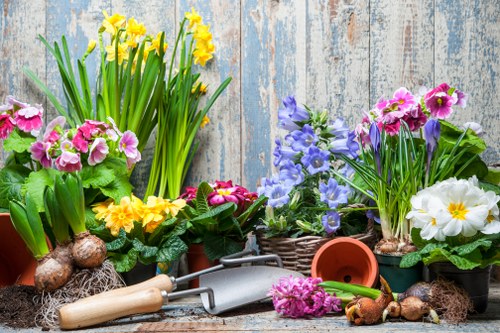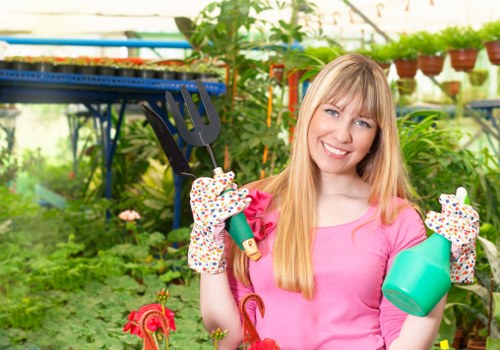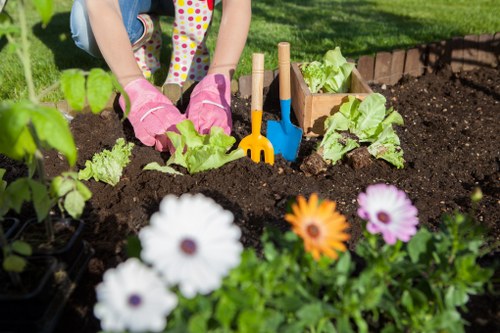Gardener Wanstead: Enhancing Your Green Spaces
Introduction to Gardener Wanstead

Welcome to Gardener Wanstead, your trusted partner in creating and maintaining beautiful gardens in the Wanstead area. Whether you're looking to design a new garden, maintain an existing one, or need expert advice on plant care, our team of experienced gardeners is here to help.
At Gardener Wanstead, we understand the importance of a well-kept garden. It not only enhances the aesthetic appeal of your home but also provides a peaceful retreat where you can relax and enjoy nature.
Our services are tailored to meet the unique needs of each client, ensuring that your garden reflects your personal style and preferences.
Our Gardening Services

We offer a wide range of gardening services to cater to all your outdoor needs. From routine maintenance to complete garden makeovers, our team is equipped with the skills and tools to deliver outstanding results.
Garden Design and Planning
Designing a garden involves careful planning and creativity. Our experts work closely with you to understand your vision and transform it into a reality. We consider factors like space, soil quality, and light conditions to create a functional and beautiful garden.
- Customized garden layouts
- Plant selection and placement
- Incorporation of hardscaping elements
Planting and Landscaping
Choosing the right plants is crucial for a thriving garden. We select plants that are suitable for the local climate and soil, ensuring they flourish with the proper care.
- Perennials and annuals
- Shrubs and trees
- Flower beds and borders
Garden Maintenance
Regular maintenance keeps your garden looking its best. Our maintenance services include pruning, weeding, lawn care, and pest management.
Why Choose Gardener Wanstead?

Choosing the right gardener is essential for the health and beauty of your garden. Here’s why Gardener Wanstead stands out:
Experienced Professionals
Our team consists of highly trained and experienced gardeners who are passionate about what they do. We stay updated with the latest gardening trends and techniques to provide the best services.
Personalized Service
We believe every garden is unique. Our personalized approach ensures that your specific needs and preferences are met, resulting in a garden that truly reflects your style.
Quality Assurance
At Gardener Wanstead, quality is our top priority. We use premium materials and follow best practices to ensure long-lasting and beautiful results.
Local Expertise in Wanstead

Being based in Wanstead, we have a deep understanding of the local climate, soil conditions, and plant varieties that thrive in this area. This local expertise allows us to provide gardening solutions that are both effective and sustainable.
We are committed to enhancing the green spaces of Wanstead, contributing to the community’s beauty and environmental health.
Our knowledge of nearby areas also means we can source plants and materials locally, supporting local businesses and reducing our carbon footprint.
Nearby Areas We Serve

In addition to Wanstead, Gardener Wanstead proudly serves several nearby areas, ensuring that more residents can enjoy our top-notch gardening services. Here are some of the areas we cover:
- Snaresbrook – Known for its picturesque parks and residential gardens.
- Leytonstone – A vibrant community with diverse gardening styles.
- Chingford – Offers beautiful natural landscapes perfect for gardening projects.
- East Wickham – A charming area with a mix of traditional and modern gardens.
- Woodford – Home to extensive green spaces ideal for garden design and maintenance.
- Highams Park – Features lush gardens and recreational areas.
- Wanstead Flats – A natural reserve that inspires many garden enthusiasts.
- Hainault – Combines urban and rural gardening elements.
- Redbridge – Offers a variety of gardening opportunities from small plots to large estates.
- Stratford – A bustling area with unique gardening needs.
- Ilford – Known for its community gardens and green initiatives.
- Greensted – Features a mix of traditional and contemporary garden designs.
- Barkingside – A residential area with beautiful private gardens.
- Redbridge Green – Offers ample space for expansive garden projects.
- Upper Waltham Common – Known for its community-driven gardening efforts.
Plant Care Tips from Gardener Wanstead
Maintaining a healthy garden involves more than just planting. Here are some essential plant care tips to keep your garden thriving:
Proper Watering
Ensure your plants receive the right amount of water. Overwatering can lead to root rot, while underwatering can cause plants to wilt and die.
- Water early in the morning to reduce evaporation.
- Use drip irrigation systems for efficient watering.
- Check soil moisture regularly.
Soil Health
Healthy soil is the foundation of a vibrant garden. Regularly amend your soil with compost and organic matter to improve its structure and fertility.
Fertilizing
Use appropriate fertilizers to provide essential nutrients to your plants. Avoid over-fertilizing, which can harm plant roots and the surrounding ecosystem.
Pest Management
Protect your garden from pests by using natural pest control methods. Encourage beneficial insects like ladybugs and lacewings to keep pest populations in check.
Sustainable Gardening Practices
At Gardener Wanstead, we believe in sustainable gardening. Implementing eco-friendly practices not only benefits your garden but also the environment.
Composting
Composting reduces waste and enriches your soil. Start a compost pile with kitchen scraps and garden waste to create nutrient-rich compost for your plants.
Rainwater Harvesting
Collecting rainwater is an excellent way to conserve water. Use rain barrels to store water for your garden, reducing reliance on tap water.
Native Plants
Incorporate native plants into your garden. They are well-adapted to the local climate and require less maintenance and water.
Seasonal Gardening Tips
Different seasons require different gardening tasks. Here are some tips to keep your garden healthy throughout the year:
Spring
Spring is the perfect time to plant new flowers and vegetables. Prepare your garden beds by removing debris and adding compost.
Summer
Ensure your plants stay hydrated during the hot months. Mulch around plants to retain moisture and reduce weed growth.
Autumn
Prepare your garden for winter by pruning dead branches and planting bulbs for spring blooms.
Winter
Protect sensitive plants from frost by covering them with blankets or using frost-resistant covers.
Transforming Your Backyard
Your backyard can be a sanctuary with the right gardening strategies. Here’s how Gardener Wanstead can help you transform your outdoor space:
Creating a Relaxing Retreat
Incorporate elements like comfortable seating, water features, and aromatic plants to create a peaceful retreat where you can unwind.
Outdoor Entertaining Areas
Designate areas for outdoor dining and entertainment. Install durable surfaces and lighting to enhance usability and ambiance.
Play Areas for Children
Make your garden child-friendly by adding play structures and safe, open spaces where kids can play and explore.
Choosing the Right Plants
Selecting the right plants is crucial for a successful garden. Here are some factors to consider:
Climate Compatibility
Choose plants that thrive in Wanstead’s climate. Consider factors like temperature, rainfall, and sunlight when selecting plants.
Soil Type
Understand your soil type and choose plants that are well-suited to it. Amend the soil as needed to improve its structure and fertility.
Maintenance Requirements
Consider how much time and effort you can dedicate to garden maintenance. Choose plants that match your maintenance capabilities.
Garden Tools and Equipment
Having the right tools makes gardening easier and more enjoyable. Here are some essential tools every gardener should have:
- Hand Trowel – For digging small holes and transplanting seedlings.
- Pruning Shears – For trimming and shaping plants.
- Loppers – For cutting thicker branches.
- Garden Hose – For watering plants efficiently.
- Wheelbarrow – For transporting soil, plants, and debris.
Investing in quality tools ensures durability and ease of use, making your gardening tasks more efficient.
Safety Tips
Always use protective gear like gloves and goggles to prevent injuries while gardening. Maintain your tools regularly to keep them in good working condition.
Garden Lighting Ideas
Proper lighting can transform your garden, making it enjoyable even after dark. Here are some lighting ideas to enhance your outdoor space:
Pathway Lighting
Install lights along walkways to guide visitors and add a decorative touch. Solar-powered lights are an eco-friendly option.
Spotlighting
Use spotlights to highlight specific plants or garden features like fountains or sculptures. This creates visual interest and depth.
Ambient Lighting
Incorporate string lights or lanterns to create a warm and inviting atmosphere. Ambient lighting is perfect for outdoor gatherings and evenings.
Creating a Sustainable Garden
Sustainability in gardening ensures that your green spaces are eco-friendly and resource-efficient. Here’s how you can create a sustainable garden:
Use Native Plants
Native plants require less water and maintenance, making them ideal for sustainable gardens. They also support local wildlife.
Composting
Turn garden waste and kitchen scraps into compost to enrich your soil naturally. Composting reduces landfill waste and provides nutrients to plants.
Rainwater Harvesting
Collect rainwater to use for watering your garden. This reduces dependence on municipal water supply and conserves water.
Reduce Chemical Use
Avoid using chemical pesticides and fertilizers. Opt for organic alternatives to protect the environment and promote healthy plant growth.
Maintaining a Healthy Lawn
A lush, green lawn is a centerpiece of any garden. Here are some tips to maintain a healthy lawn:
Regular Mowing
Mow your lawn regularly to keep it neat and prevent overgrowth. Adjust the mower height based on the season and grass type.
Proper Watering
Water your lawn deeply but infrequently to encourage deep root growth. Early morning watering reduces evaporation and fungal growth.
Fertilization
Fertilize your lawn with the appropriate nutrients to promote healthy growth. Avoid over-fertilizing, which can damage the grass.
Aeration
Aerate your lawn annually to improve soil structure and allow better air, water, and nutrient penetration.
Choosing the Right Garden Furniture
Garden furniture enhances the functionality and comfort of your outdoor space. Here are some tips for selecting the right furniture:
Material Selection
Choose materials that withstand the local climate. Teak, wrought iron, and synthetic wicker are durable and require minimal maintenance.
Comfort and Style
Opt for furniture that is both comfortable and complements your garden's aesthetic. Cushions and cushions can add a touch of luxury.
Space Planning
Arrange furniture to create focal points and designated areas for different activities like dining, lounging, or reading.
Storage Solutions
Invest in furniture with storage options to keep cushions and accessories protected from the elements when not in use.
Incorporating Water Features
Water features add tranquility and visual interest to your garden. Here are some ideas for incorporating water elements:
Fountains
Fountains provide soothing sounds and serve as a focal point in your garden. They come in various designs, from classic to modern.
Ponds
A pond attracts wildlife like frogs and dragonflies, enhancing the biodiversity of your garden.
Waterfalls
Waterfalls create a dynamic and relaxing atmosphere, adding movement and sound to your outdoor space.
Birdbaths
Birdbaths provide a source of water for birds, making your garden a haven for wildlife.
Lighting Up Your Garden Paths
Well-lit paths not only improve safety but also enhance the beauty of your garden at night. Here are some ideas:
Solar Path Lights
Solar lights are energy-efficient and easy to install. They charge during the day and illuminate your paths at night.
LED Lights
LED lights are long-lasting and come in various colors and styles, allowing you to customize the ambiance of your garden.
Stepped Lighting
Install stepped lighting along garden stairs or terraced areas to ensure safe navigation and add a decorative touch.
Maximizing Small Garden Spaces
Even small gardens can be transformed into beautiful and functional spaces with the right strategies. Here’s how:
Vertical Gardening
Utilize vertical space by installing trellises, hanging planters, and vertical garden systems. This maximizes planting areas without taking up ground space.
Multi-functional Furniture
Choose furniture that serves multiple purposes, such as benches with storage or foldable tables, to make the most of limited space.
Compact Plant Varieties
Select plants that are suitable for small spaces, such as dwarf shrubs, compact perennials, and container plants.
Smart Layout
Plan your garden layout to create the illusion of more space. Use mirrors, light colors, and strategic plant placement to enhance the sense of depth.
Enhancing Garden Privacy
Creating privacy in your garden allows you to enjoy your outdoor space without unwanted interruptions. Here are several methods:
Hedges and Fences
Planting hedges or installing fences can create natural barriers that block views and noise from neighbors.
Privacy Screens
Use lattice panels, trellises, or decorative screens to create secluded areas within your garden.
Tall Plants and Trees
Incorporate tall plants and trees strategically to enhance privacy while adding greenery and beauty to your garden.
Outdoor Structures
Install pergolas, gazebos, or arbors to create private retreats within your garden space.
Garden Paths and Walkways
Paths and walkways guide visitors through your garden and connect different areas. Here are some ideas:
Materials
Choose materials that complement your garden’s style, such as gravel, stone, brick, or wood. Each material offers a unique look and feel.
Design Patterns
Incorporate design patterns like straight, curved, or meandering paths to add visual interest and flow to your garden.
Lighting
Add lighting along paths to enhance safety and highlight the beauty of your garden at night.
Edging
Use edging materials to define the boundaries of your paths, preventing grass and plants from encroaching.
Incorporating Edible Plants
Growing your own food can be rewarding and sustainable. Here’s how to incorporate edible plants into your garden:
Herb Gardens
Herbs are easy to grow and can be planted in dedicated herb beds or containers. They add fragrance and flavor to your kitchen.
Vegetable Gardens
Create vegetable beds to grow fresh produce. Choose varieties that suit your climate and space.
Fruit Trees
Plant fruit trees like apple, pear, or cherry trees to enjoy homegrown fruits. Ensure they are placed in areas with adequate sunlight and space to grow.
Companion Planting
Use companion planting techniques to enhance growth and deter pests. Certain plants support each other’s growth when planted together.
Garden Pests and Prevention
Protecting your garden from pests is essential for plant health. Here are some tips for pest prevention:
Natural Predators
Encourage beneficial insects like ladybugs and spiders, which prey on harmful pests, to maintain a balanced ecosystem in your garden.
Barriers and Traps
Use physical barriers like nets and fences to keep pests away from your plants. Traps can also help reduce pest populations.
Organic Pesticides
Opt for organic pesticides that are environmentally friendly and safe for beneficial insects and wildlife.
Healthy Plant Practices
Maintain plant health through proper watering, fertilizing, and pruning, which can make them more resistant to pests and diseases.
Composting Basics
Composting is an eco-friendly way to recycle garden and kitchen waste into nutrient-rich soil. Here’s how to start:
Choosing a Compost Bin
Select a compost bin that suits your space and needs. Bins can be made of wood, plastic, or metal and come in various sizes.
Materials to Compost
Compostable materials include fruit and vegetable scraps, grass clippings, leaves, and small branches. Avoid composting meat, dairy, and oily foods.
Maintaining Your Compost
Turn your compost regularly to aerate it and speed up decomposition. Keep the compost moist but not waterlogged.
Using Compost
Once the compost is dark and crumbly, it’s ready to use. Spread it around your plants to improve soil fertility and structure.
Creating a Wildlife-Friendly Garden
A wildlife-friendly garden supports local biodiversity and creates a harmonious outdoor environment. Here’s how to make your garden a haven for wildlife:
Provide Food Sources
Plant a variety of flowers, shrubs, and trees that produce nectar, seeds, and berries to nourish birds, bees, and butterflies.
Water Features
Install birdbaths, ponds, or water fountains to provide water for wildlife. Ensure the water source is clean and safe.
Habitat Creation
Create shelters and nesting sites using birdhouses, bat boxes, and insect hotels to encourage wildlife to inhabit your garden.
Avoid Pesticides
Minimize or eliminate the use of pesticides to protect beneficial insects and other wildlife from harm.
FAQs About Gardener Wanstead
1. What services does Gardener Wanstead offer?
Gardener Wanstead provides a comprehensive range of gardening services, including garden design, planting, maintenance, landscaping, and sustainable gardening practices.
2. How can I schedule a consultation with Gardener Wanstead?
You can schedule a consultation by contacting us through our website or by phone. Our team will discuss your gardening needs and arrange a suitable time to visit your property.
3. Does Gardener Wanstead use eco-friendly practices?
Yes, we prioritize sustainable and eco-friendly practices such as composting, rainwater harvesting, and using native plants to create environmentally responsible gardens.
4. What areas does Gardener Wanstead serve besides Wanstead?
In addition to Wanstead, we serve nearby areas including Snaresbrook, Leytonstone, Chingford, East Wickham, Woodford, Highams Park, Wanstead Flats, Hainault, Redbridge, Stratford, Ilford, Greensted, Barkingside, Redbridge Green, and Upper Waltham Common.
5. How can I maintain my garden between professional visits?
We provide our clients with personalized maintenance tips and guidelines to help them care for their gardens between professional visits. Regular watering, proper pruning, and monitoring for pests are some of the key practices.